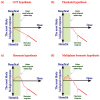Population Studies and Molecular Mechanisms of Human Radioadaptive Capabilities: Is It Time to Rethink Radiation Safety Standards?
- PMID: 39769306
- PMCID: PMC11676322
- DOI: 10.3390/ijms252413543
Population Studies and Molecular Mechanisms of Human Radioadaptive Capabilities: Is It Time to Rethink Radiation Safety Standards?
Abstract
The evolution of man on Earth took place under conditions of constant exposure to background ionizing radiation (IR). From this point of view, it would be reasonable to hypothesize the existence of adaptive mechanisms that enable the human organism to safely interact with IR at levels approximating long-term natural background levels. In some situations, the successful operation of molecular mechanisms of protection against IR is observed at values significantly exceeding the natural background level, for example, in cancer cells. In 15-25% of cancer patients, cancer cells develop a phenotype that is resistant to high doses of IR. While further investigations are warranted, the current evidence suggests a strong probability of observing positive health effects, including an increased lifespan, a reduced cancer risk, and a decreased incidence of congenital pathologies, precisely at low doses of ionizing radiation. This review offers arguments primarily based on a phenomenological approach and critically reconsidering existing methodologies for assessing the biological risks of IR to human health. Currently, in the most economically developed countries, there are radiation safety rules that interpret low-dose radiation as a clearly negative environmental factor. Nowadays, this approach may pose significant challenges to the advancement of radiomedicine and introduce complexities in the regulation of IR sources. The review also examines molecular mechanisms that may play a key role in the formation of the positive effects of low-dose IR on human radioadaptive capabilities.
Keywords: carcinogenesis; hormesis; ionizing radiation; low-dose radiation; radiation safety; radioadaptive response; radioresistance.
Conflict of interest statement
The authors declare no conflicts of interest.
Figures

Similar articles
-
Involvement of MAPK signalling in radioadaptive response in BALB/c mice exposed to low dose ionizing radiation.Int J Radiat Biol. 2016 May;92(5):249-62. doi: 10.3109/09553002.2016.1146829. Epub 2016 Feb 29. Int J Radiat Biol. 2016. PMID: 26926139
-
In vivo radioadaptive response: a review of studies relevant to radiation-induced cancer risk.Hum Exp Toxicol. 2015 Mar;34(3):272-83. doi: 10.1177/0960327114537537. Epub 2014 Jun 12. Hum Exp Toxicol. 2015. PMID: 24925363 Free PMC article. Review.
-
Insights on the Radiation-Induced Adaptive Response at the Cellular Level and Its Implications in Cancer Therapy.Cytogenet Genome Res. 2023;163(5-6):257-273. doi: 10.1159/000534500. Epub 2023 Oct 31. Cytogenet Genome Res. 2023. PMID: 37906989 Review.
-
NF-kappa B-mediated adaptive resistance to ionizing radiation.Free Radic Biol Med. 2008 Jan 1;44(1):1-13. doi: 10.1016/j.freeradbiomed.2007.09.022. Epub 2007 Oct 10. Free Radic Biol Med. 2008. PMID: 17967430 Free PMC article. Review.
-
IR-inducible clusterin gene expression: a protein with potential roles in ionizing radiation-induced adaptive responses, genomic instability, and bystander effects.Mutat Res. 2004 Dec 2;568(1):97-110. doi: 10.1016/j.mrfmmm.2004.06.049. Mutat Res. 2004. PMID: 15530543 Review.
References
-
- Li Q., Zhao G., Han W., Xu S., Wu L. Radiation Target: Moving from Theory to Practice. Nucl. Anal. 2022;1:100024. doi: 10.1016/j.nucana.2022.100024. - DOI
-
- ICRP 1990 Recommendations of the International Commission on Radiological Protection. Ann. ICRP. 1991;21:1–201. - PubMed
-
- Takahashi K., Yugi K., Hashimoto K., Yamada Y., Pickett C.J.F., Tomita M. Computational Challenges in Cell Simulation: A Software Engineering Approach. IEEE Intell. Syst. 2002;17:64–71. doi: 10.1109/MIS.2002.1039834. - DOI
Publication types
MeSH terms
LinkOut - more resources
Full Text Sources

